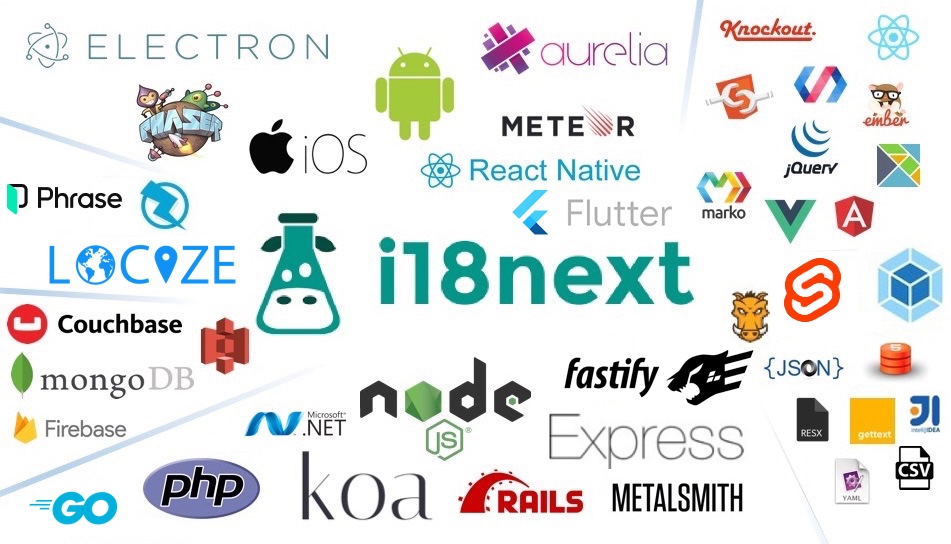Integration
- i18next:
i18next is framework-agnostic and can be integrated into any JavaScript application, including React, Vue, and Angular. It provides a flexible API and can be configured to work with various build tools and environments, making it a versatile choice for internationalization.
- react-i18next:
React-i18next is built to work with React, providing hooks and components that make it easy to manage translations within React applications. It allows for a smooth integration with React's component lifecycle, enabling dynamic language switching and translation updates.
- vue-i18n:
Vue-i18n is tailored for Vue.js applications, offering a simple API for managing translations and localization. It integrates well with Vue's reactivity system, allowing for automatic updates of translations when the language changes.
- next-i18next:
Next-i18next is specifically designed for Next.js applications, providing a seamless integration with the framework's server-side rendering capabilities. It simplifies the process of adding i18n support to Next.js projects, ensuring that translations are available during server-side rendering.
- angular-translate:
Angular-translate integrates seamlessly with AngularJS, allowing developers to easily manage translations within their AngularJS applications. It leverages Angular's dependency injection system, making it straightforward to inject translation services into controllers and components.
Features and Flexibility
- i18next:
i18next offers a rich set of features, including support for interpolation, pluralization, context-based translations, and nested translations. It also supports multiple backends for loading translations, making it highly flexible for various application needs.
- react-i18next:
React-i18next provides a comprehensive set of features tailored for React applications, including hooks for functional components, support for lazy loading of translations, and context-based translations. It allows for a high degree of flexibility in managing translations within the React ecosystem.
- vue-i18n:
Vue-i18n supports a wide range of features, including message formatting, pluralization, and date/number formatting. It is designed to work seamlessly with Vue's reactivity system, providing a flexible and powerful solution for localization in Vue applications.
- next-i18next:
Next-i18next inherits the features of i18next while adding support for Next.js specific functionalities, such as server-side rendering and automatic language detection. This makes it a powerful choice for SEO-focused applications that require robust i18n capabilities.
- angular-translate:
Angular-translate provides essential features for managing translations, including support for dynamic loading of translation files, interpolation, and pluralization. However, it may lack some advanced features found in more modern libraries, making it less flexible for complex applications.
Performance
- i18next:
i18next is optimized for performance, with features like lazy loading of translations and caching mechanisms to reduce the overhead of loading translation files. This makes it suitable for large applications with extensive localization requirements.
- react-i18next:
React-i18next is designed to be performant within React applications, utilizing hooks to minimize re-renders and optimize translation updates. It allows for fine-grained control over when components re-render based on translation changes, enhancing performance.
- vue-i18n:
Vue-i18n is built to be efficient within Vue.js applications, leveraging Vue's reactivity system to ensure that only components that depend on translations re-render when the language changes. This results in a performant localization experience.
- next-i18next:
Next-i18next maintains the performance benefits of i18next while ensuring that translations are available during server-side rendering. This approach minimizes the loading time for users and enhances the overall performance of Next.js applications.
- angular-translate:
Angular-translate is generally performant for small to medium-sized applications. However, it may face performance issues with large translation files or complex applications due to its reliance on AngularJS's digest cycle for updates, which can lead to unnecessary re-renders.
Community and Support
- i18next:
i18next has a large and active community, providing extensive documentation, tutorials, and support resources. This makes it easier for developers to find help and best practices for implementing internationalization in their applications.
- react-i18next:
React-i18next has a strong community and is widely used in the React ecosystem, providing ample resources, documentation, and community support. This makes it a reliable choice for developers looking for help with internationalization in React applications.
- vue-i18n:
Vue-i18n is well-supported within the Vue.js community, offering comprehensive documentation and resources. It is actively maintained and widely used, making it a trusted choice for localization in Vue applications.
- next-i18next:
Next-i18next benefits from the growing Next.js community, with increasing resources and support available. As a relatively newer library, it is actively maintained and updated to keep pace with Next.js developments.
- angular-translate:
Angular-translate has a smaller community compared to more modern libraries, which may limit the availability of resources and support. However, it is still maintained and can be a viable option for AngularJS applications.























